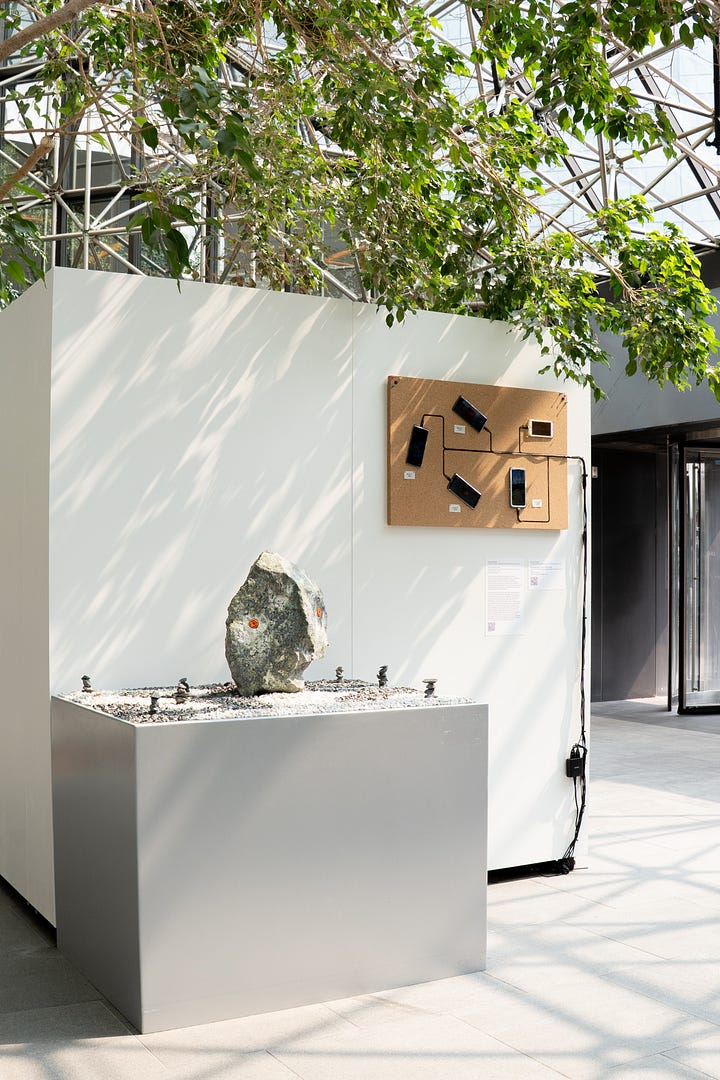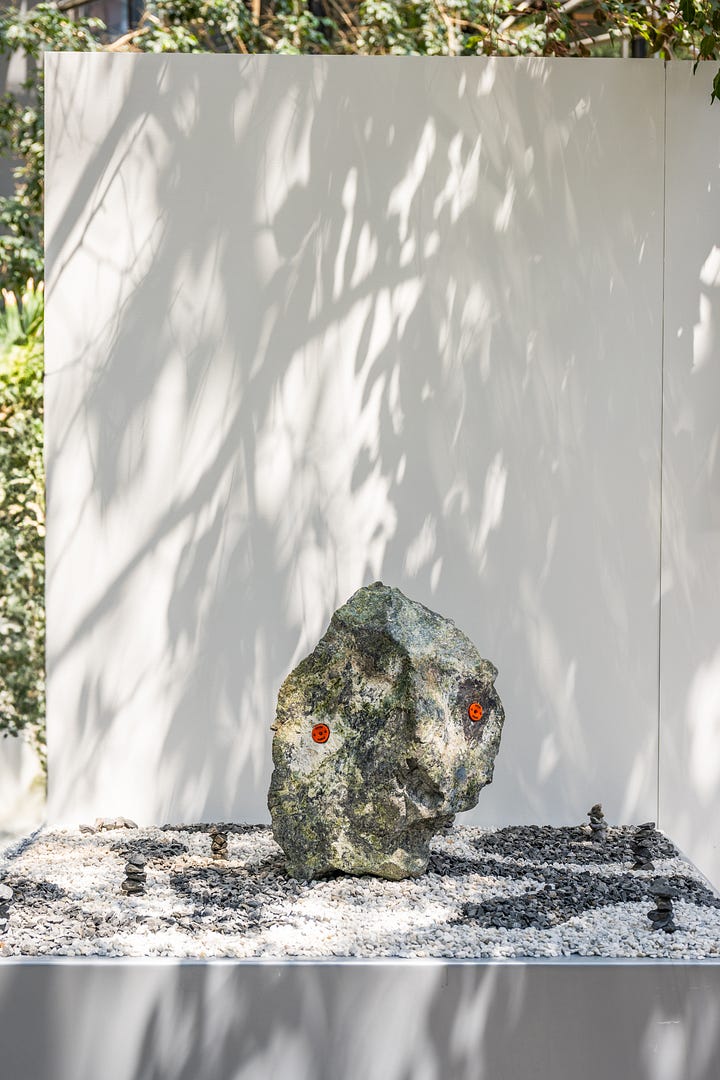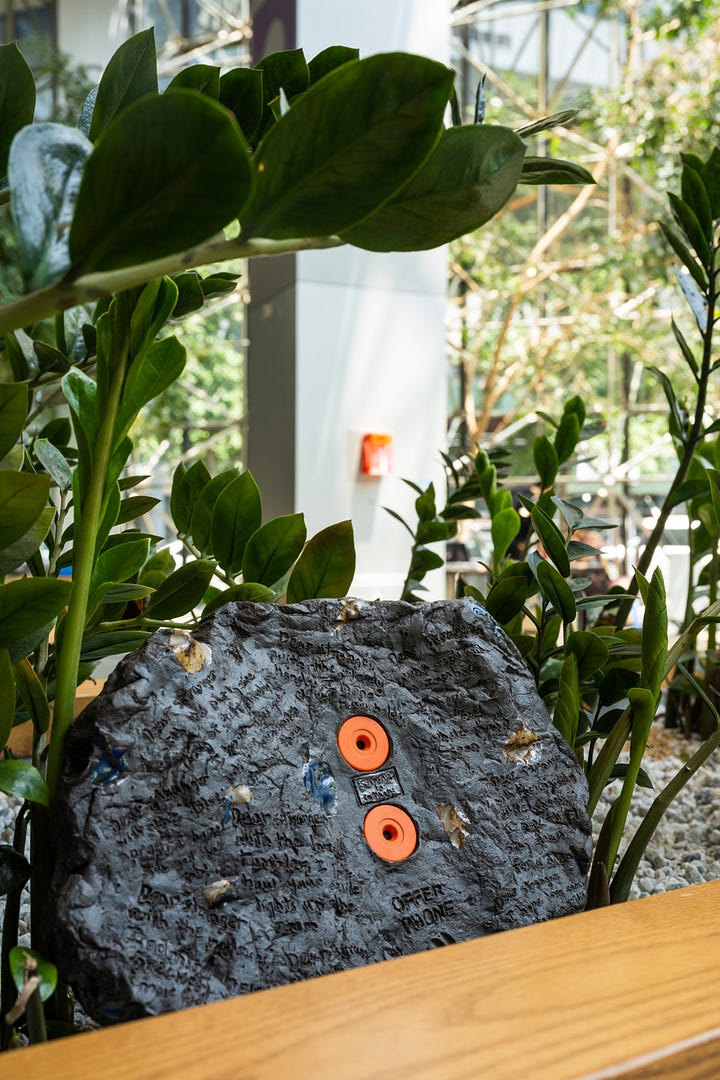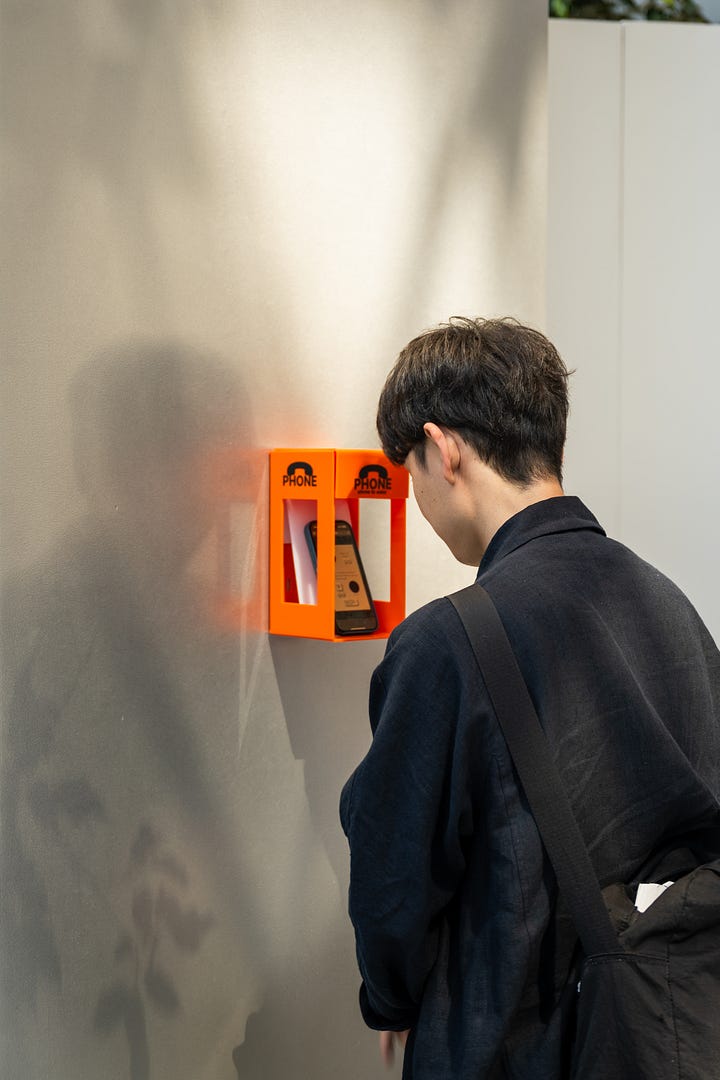computing shrines: play as kindling for liberation
on communal websites in sculptures, the title of this newsletter, and perpetual energy
Last weekend, I shared the culmination of an idea seeded 2+ years ago. At a large, open-air office building in Manhattan (180 Maiden Lane by WSA), four sculptures invited visitors to offer up their phones to connect with past and future visitors.
In the weeks leading up to it, I shipped a 100lb+ rock from San Francisco, learned to use a CNC on a large corkboard, and created 3 distinctive and expressive tiny social networks.
DEMO2025 is the showcase of the latest work from NEW INC, the New Museum's art and technology incubator. I flew in a week early and spent the weekend prior installing so that everything was ready for the show. It's the largest physical installation I've ever worked: featuring 4 distinct works joined by a single unifying project, Computing Shrines. In parallel, I prepped a 7-minute talk that could give a compelling overview of my creative practice and why it exists.
Afterwards, I couldn't sleep from all the adrenaline coursing through my body, all the conversations running through my head and the ideas branching off from them.




Computing Shrines is a series of site-specific sculptures that co-opt our devices to foster local connection in everyday places. Each shrine connects visitors' phones to a custom communal web interface that facilitates exchange of small intimacies between past and future visitors. Beyond an installation, Computing Shrines is an open protocol for creating public good technology that fosters local connection rather than replacing it. Designed with common materials, open-sourcing the interfaces, and collaborating with local stewards, the project transforms the normally solitary and exclusive act of creating technology into a community improvement project for all to shape.
The installation features three distinct shrines, anchored around Shrine Map, an homage to community bulletin boards featuring a smartphone for each shrine. Two mobile phone booths sit on columns across from each other, inviting visitors to listen and share their worries and hopes with the last and next stranger in Shrine to Voice. Shrine to Earth features a found boulder and rock garden that invites visitors to share photos of rocks they’ve found, which become pieces in a cairn-making mini-game. And in Shrine to Others, a clay tablet nestled beside a seating area invites visitors to notice the people they share the space with and share what they admire about strangers.
In the talk, I described Computing Shrines as a culmination of my practice, and in many ways, it is: the combination of intimate, empowering technology and person-to-person connection & community. But rather than a linear path as we like to interpret stories, it feels more like a perpetual spiral.
All my work provided the foundation for this project, but these projects aren’t mere stepping stones towards this final piece. Instead, I will certainly circle back to them over the years—the different perspectives that lead me to this particular creation. I imagine my work expanding in all directions, like an exploding star rather than climbing a ladder to the top.
Technology that facilitates local connection is important and interesting. But there is still value to purely digital connection, creation, and play. We exist in a web of contradictions—our very existence sometimes feels like one. We are not so simple as to be contained by a single right answer. Instead, I'm seeking answers in plurality, complexity, and the infinite possibilities that the world and other people offer us every day.

It feels weird to show my work in this context—a big production team, curators, photographers, and art handlers. There's an elevated sense of importance, which can be helpful to encourage people to deeply engage (as well as celebrate thework). But there's an artificial feeling that I can't shake—in that this is not the form that I imagine people interacting with my work.
I want these Shrines to be living out in the world amongst our daily lives. I want them to be nestled in subway stations, neighborhood parks, alleyways and mailboxes, cafes, and sidewalk plant beds. I want them to be a pleasant surprise you stumble into on your regular stroll. I want them to encourage your curiosity—to stoke the wonder that the world coaxes out of you every waking moment.
Still, even in this environment, I noticed the patterns that I hoped for: visitors sneaking away to private corners to listen and record a voice message for a future visitor; people bringing rock offerings and creating their own cairns atop Shrine to Earth; others sitting, lying, and kneeling by Shrine to Others to gaze at the people around them, returning to their phones to record what they notice.
I wander around and try to hear people's honest reactions. A few have trouble accessing the website. Others light up about how cool it is. Universally, I observe curiosity and a desire to learn more. When I share the background and hope behind the idea, I see their faces change as they "get it" and start applying the framework in their own histories and homes. They imagine shrines on airplanes, beside conference seats, at local cafes, set into random street walls, hanging from a street-level window—a vision of technology situated to physical contexts and that empowers us to learn about, and thus, form trust with, those around us.
I watch as the possibilities expand and multiply, and they slowly grow the conviction to host one of their own, to take technology into their own hands and shape it in a way that can engage with people at an unexpectedly meaningful level.
I'm looking for others to grow this project with me next! Message or email me (spencer@spencer.place) if you're interested in hosting a Shrine in your own neighborhood or work together on one for your organization. I'd love for these to be a way for local businesses to host art experiences that also facilitate connection within their communities.
Seeing all the energy around the protests in the U.S. against the indiscriminate and brutal detainments by ICE, I'm reminded of the ends for which I do my work. This kind of gathering, solidarity, and collective demand & fight for change is what I believe technology offers potential to empower. We already see it in clever creations that facilitate the organizing of these kinds of events, secure communication during, and systems to disrupt institutional control. People are using their diverse social media audiences to bring attention to these issues and host gatherings in solidarity even when they can't attend physically.
This level of commitment doesn't appear instantly. People aren't convinced of a cause or their need to participate overnight. These movements, for a world where everyone can live a dignified life, or, in short, a better world for all, happen slowly over decades and even centuries. With every generation, we move the needle further on our notions of equality and liberty and get closer to this fleeting idea of truth.
And importantly, I believe these movements can't flourish solely through these serious, radical actions like protests, facts, and resistance. These are all essential factors, but we need a foundation where we are willing to stand up for our neighbors, to risk ourselves for a greater cause. I believe this foundation forms through lightness—joy, play, boredom. We must say hi to each other at the coffee shop, lend out groceries and tools to our neighbors, and play and joke with each other before we can form the trust to fight together.
Creating space for joy and play is as radical as creating space for protest and solidarity. In fact, they might circle each other in one single spiral. At least, that's what my hypothesis is.
My talk focused on this paradox of perpetual energy that I seek through all my work. It reminded me of the title of this newsletter: spencer's paradoxes. I've always felt drawn to holding contradictions in balance as a means to get closer to some deeper truth. I like playing with ideas, experimenting with provocations, designing things that cause people to say “what if?” a thousand times over. A question mark is the seed of change, so let's plant some more questions in each other's hearts and go looking for the answers together.
Recent Updates
optional support I've decided to enable optional paid subscriptions for this newsletter! I already run an optional sponsorship program with Github, but I've gotten feedback from people having to make an account to support me. If you're an existing sponsor (or you have Github and would like to support there), don't worry—you'll be automatically associated with a free "paid" subscription on here for any bonus behind-the-scenes work I publish. Have ideas for what would be fun to offer to supporters while keeping most of my content free? I'd love to hear.
workshops in New York I'm hosting two "Touching Computers" workshops this week to make interactive NFC objects: one will be creating them out of meaningful objects we own with Munus Shih and the other will be my first event designed for children and their parents working with clay with Irena Wang and her son Luka.
Show closes June 22nd Starting around 4pm I'll be in the space to host walkthroughs and a small celebration. come if you're around! You can also watch the talk I gave on Youtube, and learn more about the project on the case study published by APOSSIBLE.
website update I quite like how this bottom row of my personal website is turning out! The “stats” box with the little colors for people brings me a lot of joy
This dispatch was sent to 1559 inboxes. My writing is always free and open, but I am independently funded and appreciate any support you can offer. Consider sharing this with a friend and becoming a patron or subscribing for the warm & fuzzy feeling of supporting an indie artist (and access to the community & works-in-progress)
Thank you to the 24 people who supported my independent work with a monthly sponsorship last month: Shaobo, Janvi, Raymond, Jacky, Sunil, Jess, Tim, Sarah, Jon, soft networks, Nikhil, Alejandro, Andy, Caro, Charles, James, Crystal, Dan, Jonah, Rachel, Gleb, Yorke, Brandon, and one anonymous donor.






"But there's an artificial feeling that I can't shake—in that this is not the form that I imagine people interacting with my work."
I find that any work derived with or from the web wants to be a public good.
What an amazing accomplishment and lovely exhibition of your work, Spencer!
I’m sad to miss the Touching Computers event but will have to attend one in the future